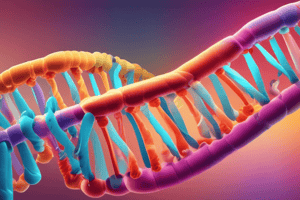Podcast
Questions and Answers
Vilken process beskriver dubbelgöringen av DNA innan celler delar sig?
Vilken process beskriver dubbelgöringen av DNA innan celler delar sig?
- Mutation
- Transkription
- Replikation (correct)
- Translation
Vad är huvudsyftet med transkription i cellen?
Vad är huvudsyftet med transkription i cellen?
- Dubbelgöring av DNA
- Immunrespons
- Översättning av mRNA till proteiner (correct)
- Tillverkning av hormoner
Vilket av följande kan orsaka mutationer i genetisk sekvens?
Vilket av följande kan orsaka mutationer i genetisk sekvens?
- För mycket motion
- Exponering för radiovågor (correct)
- Exponering för solljus
- Intag av vitaminer
Vad är huvudfunktionen för ribosomer inom översättningsprocessen?
Vad är huvudfunktionen för ribosomer inom översättningsprocessen?
Vilken process kan ge evolutionära fördelar trots att den kan orsaka organs funktionsfel?
Vilken process kan ge evolutionära fördelar trots att den kan orsaka organs funktionsfel?
Vad är huvudsyftet med tRNA inom översättningsprocessen?
Vad är huvudsyftet med tRNA inom översättningsprocessen?
Hur kan mutationer påverka gener och därmed bidra till olika sjukdomar?
Hur kan mutationer påverka gener och därmed bidra till olika sjukdomar?
Vad är det som exakt replikeras under DNA-replikationen?
Vad är det som exakt replikeras under DNA-replikationen?
Vilken roll har ribosomer vid translationen av mRNA?
Vilken roll har ribosomer vid translationen av mRNA?
Hur kan externa faktorer som strålning eller kemikalier påverka mutationstakten i en cell?
Hur kan externa faktorer som strålning eller kemikalier påverka mutationstakten i en cell?
Flashcards are hidden until you start studying
Study Notes
DNA and RNA: Two Pillars of Genetic Information
Imagine if every book contained instructions for writing itself—that's roughly how DNA and its cousin molecule RNA function within living organisms. These nucleic acids serve as the blueprints for life, carrying all the information required to build cells and pass traits from one generation to another. Let's delve into their roles in encoding our genes, transcribing messages, maintaining fidelity through mutations, making copies via replication, and ultimately translating those sequences into proteins.
Genetic Code
The central dogma of molecular biology dictates that information flows from DNA to RNA (transcription) and then to protein (translation), never the other way around. The genetic code is the set of rules specifying which combinations of four chemical building blocks called nucleotides—adenine (A), cytosine (C), guanine (G), and thymine (T) in DNA; uracil (U) instead of T in RNA—correspond to each amino acid. This code provides the recipe for creating 20 unique varieties of amino acids used in constructing cellular structures and functional proteins.
Transcription
This process involves copying DNA's genetic message directly into RNA using enzymes like RNA polymerase. This transfer occurs primarily during cell division when new cells require the necessary genetic material to grow properly. However, some cells also undergo transcription continuously due to specific functions such as immune response or producing hormones.
Mutation
Mutations arise whenever something goes wrong with either DNA replication or transcription processes, leading to changes in the genetic sequence. They can occur naturally or result from exposure to radiation, chemicals, viruses, etc., affecting individual genes or entire chromosomes. Not all mutations lead to negative consequences: sometimes they contribute positively by providing evolutionary advantages, while others may render organs dysfunctional, causing diseases.
Replication
Replication refers to the doubling of DNA before dividing cells separate themselves into two distinct daughter cells containing identical genetic material. Enzymes such as DNA polymerases read existing DNA strands and synthesize complementary strands based on their templates (anti-parallel strand pairing: A pairs only with T, G with C). The newly formed double helix serves as a template for further rounds of replication upon Cell Division.
Translation
In this last step of gene expression, ribonucleoprotein complexes known as ribosomes translate the mRNA into proteins following the genetic code, linking together corresponding amino acids, just as written by the DNA sequence.
Learning more about these fundamental biological processes will help us understand intricate mechanisms underlying health and disease and potentially allow us to manipulate them to improve human well-being and the environment.
Studying That Suits You
Use AI to generate personalized quizzes and flashcards to suit your learning preferences.




